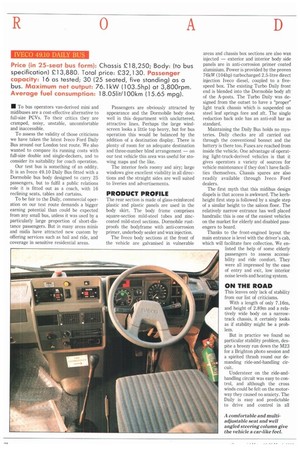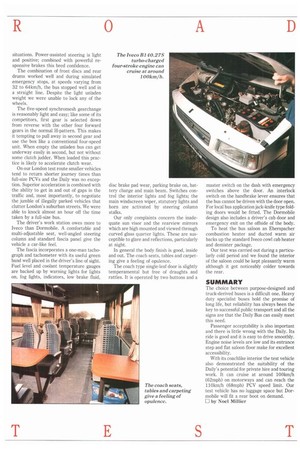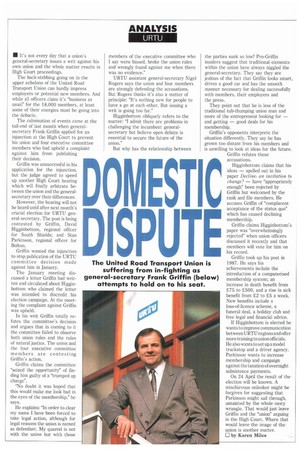• To bus operators van-derived mini and midibuses are a
Page 30

Page 32

Page 34

If you've noticed an error in this article please click here to report it so we can fix it.
cost-effective alternative to full-size PCVs. To their critics they are cramped, noisy, unstable, uncomfortable and inaccessible.
To assess the validity of those criticisms we have taken the latest Iveco Ford Daily Bus around our London test route. We also wanted to compare its running costs with full-size double and single-deckers, and to consider its suitability for coach operation.
Our test bus is something of an oddity. It is an Iveco 49.10 Daily Bus fitted with a Dormobile bus body designed to carry 25 passengers, but to fulfil a public relations role it is fitted out as a coach, with 16 reclining seats, tables and curtains.
To be fair to the Daily, commercial operation on our test route demands a bigger earning potential than could be expected from any small bus, unless it was used by a particularly large proportion of short-distance passengers. But in many areas minis and midis have attracted new custom by offering services such as hail and ride, and coverage in sensitive residential areas. Passengers are obviously attracted by appearance and the Dormobile body does well in this department with uncluttered, attractive lines. Perhaps the large windscreen looks a little top heavy, but for bus operation this would be balanced by the addition of a destination display. There is plenty of room for an adequate destination and three-number blind arrangement — on our test vehicle this area was useful for stowing maps and the like.
The interior feels roomy and airy; large windows give excellent visibility in all directions and the straight sides are well suited to liveries and advertisements.
PRODUCT PROFILE
The rear section is made of glass-reinforced plastic and plastic panels are used in the body skirt. The body frame comprises square-section mild-steel tubes and zinccoated mild-steel sections. Dormobile rustproofs the bodyframe with anti-corrosion primer, underbody sealer and wax injection.
The Iveco body sections at the front of the vehicle are galvanised in vulnerable areas and chassis box sections are also wax injected — exterior and interior body side panels are in anti-corrosion primer coated aluminium. Power is provided by the proven 76kW (104hp) turbocharged 2.5-litre direct injection Iveco diesel, coupled to a fivespeed box. The existing Turbo Daily front end is blended into the Dormobile body aft of the A-posts. The Turbo Daily was designed from the outset to have a "proper" light truck chassis which is suspended on steel leaf springs fore and aft. The single reduction back axle has an anti-roll bar as standard.
Maintaining the Daily Bus holds no mysteries. Daily checks are all carried out through the conventional bonnet and the battery is there too. Fuses are reached from inside the vehicle. One advantage of operating light-truck-derived vehicles is that it gives operators a variety of sources for vehicle maintenance if they don't have facilities themselves. Chassis spares are also readily available through Iveco Ford dealers.
The first myth that this midibus design dispels is that access is awkward. The kerbheight first step is followed by a single step of a similar height to the saloon floor. The relatively narrow entrance has well placed handrails: this is one of the easiest vehicles on the market for elderly and disabled passengers to board.
Thanks to the front-engined layout the main entrance is level with the driver's cab, which will facilitate fare collection. We enlisted the help of some elderly passengers to assess accessibility and ride comfort. They were all impressed by the ease of entry and exit, low interior noise levels and heating system.
ON THE ROAD
This leaves only lack of stability from our list of criticisms.
With a length of only 7.16m, and height of 2.89m and a relatively wide body on a narrowtrack chassis, it certainly looks as if stability might be a problem.
But in practice we found no particular stability problem, despite a breezy run down the M23 for a Brighton photo session and a spirited thrash round our demanding ride-and-handling circuit.
Understeer on the ride-andhandling circuit was easy to control, and although the cross winds could be felt on the motorway they caused no anxiety. The Daily is easy and predictable to drive and control in all situations. Power-assisted steering is light and positive; combined with powerful responsive brakes this bred confidence.
The combination of front discs and rear drums worked well and during simulated emergency stops, at speeds varying from 32 to 64km/h, the bus stopped well and in a straight line. Despite the light unladen weight we were unable to lock any of the wheels.
The five-speed synchromesh gearchange is reasonably light and easy; like some of its competitors, first gear is selected down from reverse with the other four forward gears in the normal H-pattern. This makes it tempting to pull away in second gear and use the box like a conventional four-speed unit. When empty the unladen bus can get underway easily in second, but not without some clutch judder. When loaded this practice is likely to accelerate clutch wear.
On our London test route smaller vehicles tend to return shorter journey times than full-size PCVs and the Daily was no exception. Superior acceleration is combined with the ability to get in and out of gaps in the traffic and, most importantly, to negotiate the jumble of illegally parked vehicles that clutter London's suburban streets. We were able to knock almost an hour off the time taken by a full-size bus.
The driver's work station owes more to Iveco than Dormobile. A comfortable and multi-adjustable seat, well-angled steering column and standard fascia panel give the vehicle a car-like feel.
The fascia incorporates a one-man tachograph and tachometer with its useful green band well placed in the driver's line of sight. Fuel level and coolant temperature gauges are backed up by warning lights for lights on, fog lights, indicators, low brake fluid, disc brake pad wear, parking brake on, battery charge and main beam. Switches control the interior lights and fog lights; the main windscreen wiper, statutory lights and horn are activated by steering column stalks.
Our only complaints concern the inadequate sun visor and the rearview mirrors which are high mounted and viewed through curved glass quarter lights. These are susceptible to glare and reflections, particularly at night.
In general the body finish is good, inside and out. The coach seats, tables and carpeting give a feeling of opulence.
The coach type single-leaf door is slightly temperamental but free of draughts and rattles. It is operated by two buttons and a master switch on the dash with emergency switches above the door. An interlock switch on the handbrake lever ensures that the bus cannot be driven with the door open. For local bus application jack-knife type folding doors would be fitted. The Dormobile design also includes a driver's cab door and emergency exit on the offside of the body.
To heat the bus saloon an Eberspacher combustion heater and ducted warm air backs up the standard Iveco cowl cab heater and demister package.
Our test was carried out during a particularly cold period and we found the interior of the saloon could be kept pleasantly warm although it got noticeably colder towards the rear.
The choice between purpose-designed and truck-derived buses is a difficult one. Heavy duty specialist buses hold the promise of long life, but reliability has always been the key to successful public transport and all the signs are that the Daily Bus can easily meet this need.
Passenger acceptability is also important and there is little wrong with the Daily. Its ride is good and it is easy to drive smoothly. Engine noise levels are low and its entrance step and flat saloon floor make for excellent accessibility.
With its coachlike interior the test vehicle also demonstrated the suitability of the Daily's potential for private hire and touring work. It can cruise at around 1001cm/h (62mph) on motorways and can reach the 110km/h (68mph) PCV speed limit. Our test vehicle has no luggage space but Dormobile will fit a rear boot on demand.
0 by Noel Millier • It's not every day that a union's general-secretary issues a writ against his own union and the whole matter results in High Court proceedings.
The back-stabbing going on in the upper echelons of the United Road Transport Union can hardly impress employers or potential new members. And while all officers claim it's "business as usual" for the 18,000 members, at least some of their energies must be going into the debacle.
The culmination of events came at the tail-end of last month when generalsecretary Frank Griffin applied for an injunction at the High Court to prevent his union and four executive committee members who had upheld a complaint against him from publishing their decision.
Griffin was unsuccessful in his application for the injunction, but the judge agreed to speed up another High Court hearing which will finally arbitrate between the union and the generalsecretary over their differences.
However, the hearing will not be heard until after next month's crucial election for URTU general-secretary. The post is being contested by Griffin, David Higginbottom, regional officer for South Shields; and Stan Parkinson, regional officer for Bolton.
Griffin wanted the injunction to stop publication of the URTU committee decision made against him in January.
The January meeting discussed a letter Griffin had written and circulated about Higginbottom who claimed the letter was intended to discredit his election campaign. At the meeting the complaint against Griffin was upheld.
In his writ Griffin totally refutes the committee's decision and argues that in coming to it the committee failed to observe both union rules and the rules of natural justice. The union and the four executive committee members are contesting Griffin's action.
Griffin claims the committee seized the opportunity" of finding him guilty of a "trumped up charge".
"No doubt it was hoped that this would make me look bad in the eyes of the membership," he says.
He explains: "In order to clear my name I have been forced to take legal action, although for legal reasons the union is named as defendant. My quarrel is not with the union but with those members of the executive committee who I say were biased, broke the union rules and wrongly found against me when there was no evidence."
URTU assistant general-secretary Nigel Rogers says the union and four members are strongly defending the accusations. But Rogers thinks it's also a matter of principle: "It's nothing new for people to have a go at each other. But issuing a writ is going too far."
Higginbottom obliquely refers to the matter: "I admit there are problems in challenging the incumbent generalsecretary but believe open debate is essential to secure the future of the union."
But why has the relationship between the parties sunk so low? Pro-Griffin insiders suggest that traditional elements within the union have always niggled the general-secretary. They say they are jealous of the fact that Griffin looks smart, drives a good car and has the smooth manner necessary for dealing successfully with members, their employers and the press.
They point out that he is less of the traditional tub-thumping union man and more of the entrepreneur looking for — and getting — good deals for his membership.
Griffin's opponents interprete the situation differently. They say he has grown too distant from his members and is unwilling to look at ideas for the future. Griffin refutes these accusations.
Higginbottom claims that his ideas — spelled out in his paper Decline: an invitation to change? — have "appropriately enough" been rejected by Griffin but welcomed by the rank and file members. He accuses Griffin of "complacent acceptance of the status quo" which has caused declining membership.
Griffin claims Higginbottom's paper was "overwhelmingly rejected" when union officers discussed it recently and that members will vote for him on his record.
Griffin took up his post in 1987. He says his achievements include the introduction of a computerised membership system; an increase in death benefit from £75 to £500, and a rise in sick benefit from £2 to £5 a week. New benefits include a loss-of-licence scheme, a funeral deal, a holiday club and free legal and financial advice.
If Higginbottom is elected he wants to improve communication between URTU regions and offer more training to union officials. He also wants to set up a model truckstop and a driver agency. Parkinson wants to increase membership and campaign against the taxation of overnight subsistence payments.
On 24 April the result of the election will be known. A mischievous onlooker might be forgiven for suggesting that Parkinson might sail through, untainted by the whole nasty wrangle. That would just leave Griffin and the "union" arguing in the High Court. Where that would leave the image of the union is another matter.
LI by Karen Miles




















































































